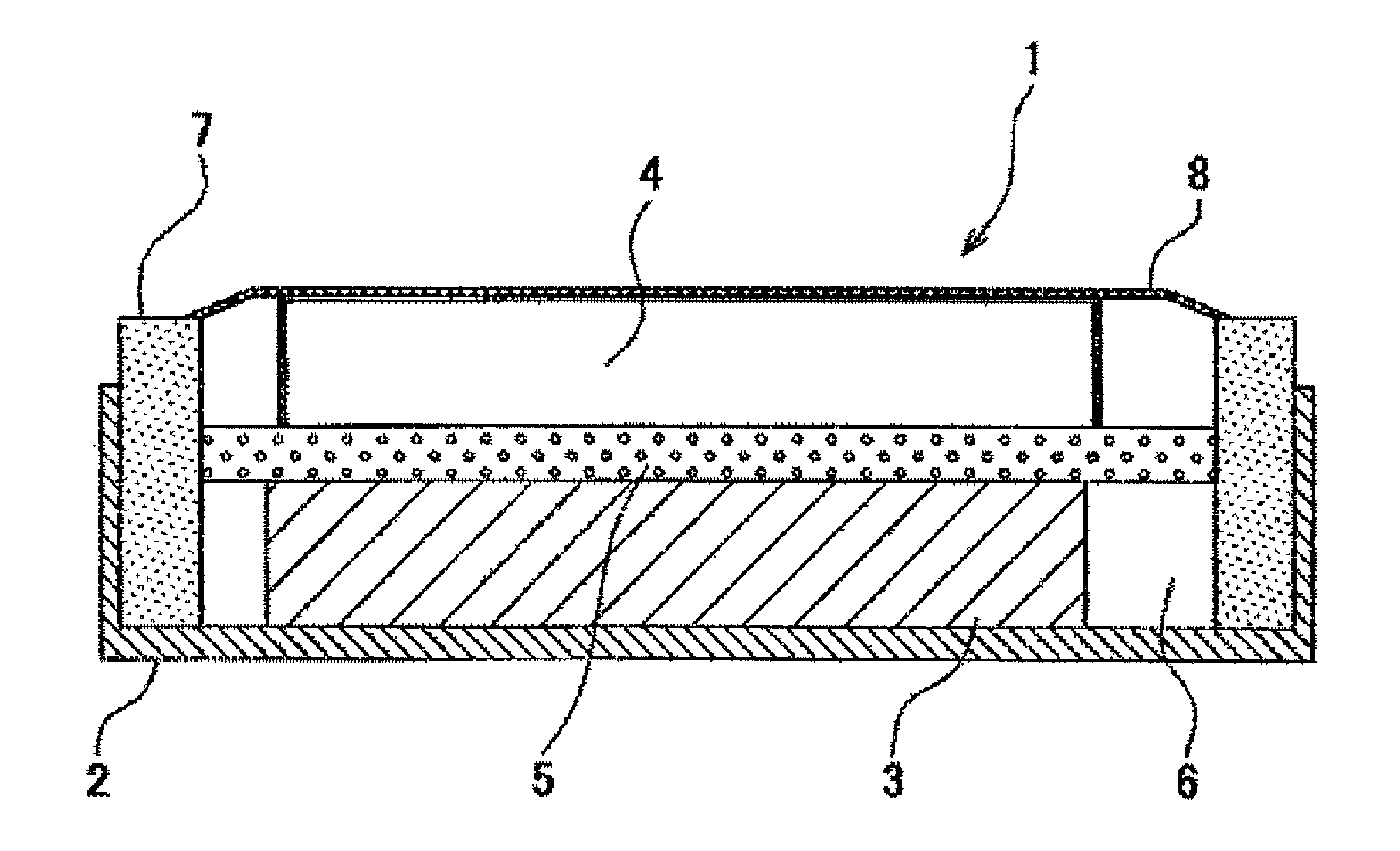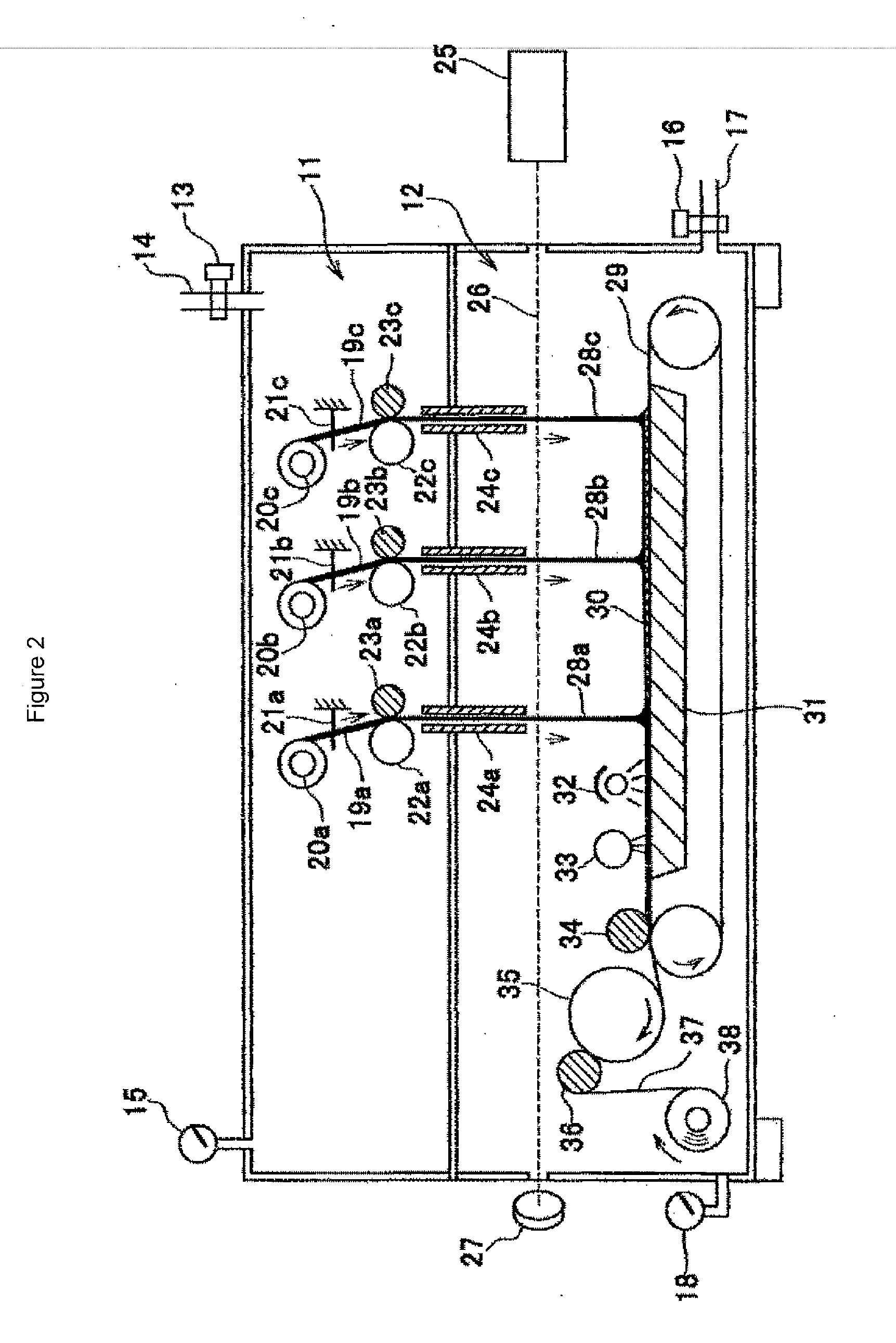Battery separator comprising a polyolefin nanofilament porous sheet
a polyolefin nanofilament and separator technology, applied in the field of battery separator comprising a porous sheet, can solve the problems of insufficient fineness of filament obtained in this manner, complicated process, and limitation of film method, and achieve low internal resistance, good conductivity, and high porosity ratio
- Summary
- Abstract
- Description
- Claims
- Application Information
AI Technical Summary
Benefits of technology
Problems solved by technology
Method used
Image
Examples
example 1
[0061]163.2 μm polypropylene filaments were prepared as original filaments. The weight average molecular weight of the polymer was 349,000, and the number average molecular weight was 89,300. The isotacticity was 92.4%. In the equipment shown in FIG. 3, the laser beam diameter of the laser generated by the carbon dioxide gas laser emitting device was 3.5 mm. The experiment was conducted using an internal orifice diameter of 0.3 mm, seven orifices and filament supply rate of 0.1 m / min. The drawing ratios calculated using the filament diameter when the laser power was changed from 10 W to 25 W at a degree of vacuum in the drawing chamber of 10 kPa are shown in Table 2. According to the data in Table 2, the average filament diameter was already in the nanofilament zone when the laser power was 10 W, and the standard deviation for the filament diameter distribution was as low as 0.12. Thus the calculated drawing ratio exceeded 200,000. The standard deviation further decreased to 0.0455 ...
example 2
[0062]Differential scanning calorimetry (DSC) measurements were conducted on the filaments obtained in Example 1, described above, and the results are shown in Table 3 and FIG. 8. The FIG. 8 showed that the endothermic peak was suddenly sharpened upon drawing, indicating increase in crystallinity. The table 3 also showed increase in melting point, the heat of fusion (ΔHm) and the crystallinity indices (Xc) as average filament diameter (day) decreased. These results suggested the enhanced molecular orientation in the filaments.
TABLE 3TmΔHmXcdavSample(° C.)(J / g)(%)(nm)Original159.9−95.8445.9163.2FilamentPower 10 W158.7 / 163.1−104.0749.80.364Power 15 W161.6−106.0850.80.339Power 20 W160.7−110.6452.90.220Power 25 W160.0−108.851.10.188Filament supply rate: 0.1 m / minP2: 10 kPa
example 3
[0063]The equipment in Example 1 was used with the same original filaments. The filaments were directly wound for ten minutes on a winding tube in the lower section (FIG. 3) using a drawing chamber with a degree of vacuum of 20 kPa, filament supply rate of 0.1 m / min and laser power of 20 W. The wound sheet was cut from the winding tube to obtain porous sheets 18 cm wide, 17 cm long, with a weight of 4.16 g / m2 and average filament diameter of 0.409 μm. A single layer laminated cell with a battery separator obtained using this sheet was prepared (FIG. 9), and various properties of the battery were measured. The results are shown in Tables 4 and 5. Now, the comparative example was a monoaxially drawn porous polypropylene film (trade name “CELGARD,” 25 μm thick). The positive electrode of the battery was a molded product containing 89 wt % LiCoO2, 6 wt % conductive carbon black and 5 wt % binder [poly(vinylidene fluoride)]. The negative electrode was molded using 90 wt % mesocarbon grap...
PUM
| Property | Measurement | Unit |
|---|---|---|
| diameter | aaaaa | aaaaa |
| temperature | aaaaa | aaaaa |
| melting point | aaaaa | aaaaa |
Abstract
Description
Claims
Application Information
 Login to View More
Login to View More - R&D
- Intellectual Property
- Life Sciences
- Materials
- Tech Scout
- Unparalleled Data Quality
- Higher Quality Content
- 60% Fewer Hallucinations
Browse by: Latest US Patents, China's latest patents, Technical Efficacy Thesaurus, Application Domain, Technology Topic, Popular Technical Reports.
© 2025 PatSnap. All rights reserved.Legal|Privacy policy|Modern Slavery Act Transparency Statement|Sitemap|About US| Contact US: help@patsnap.com



